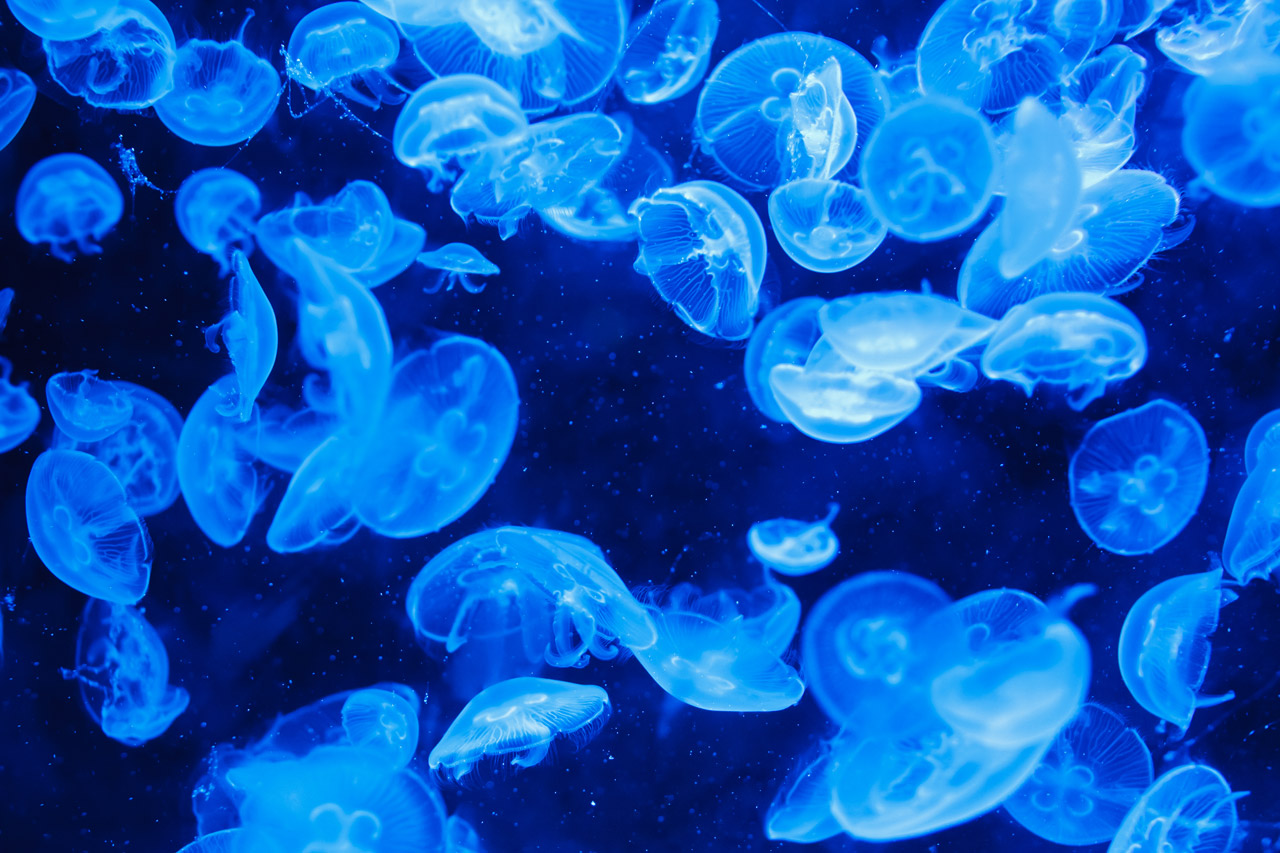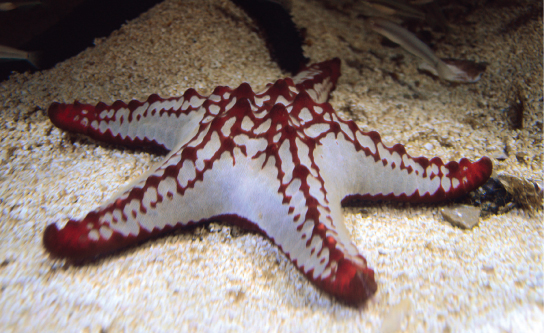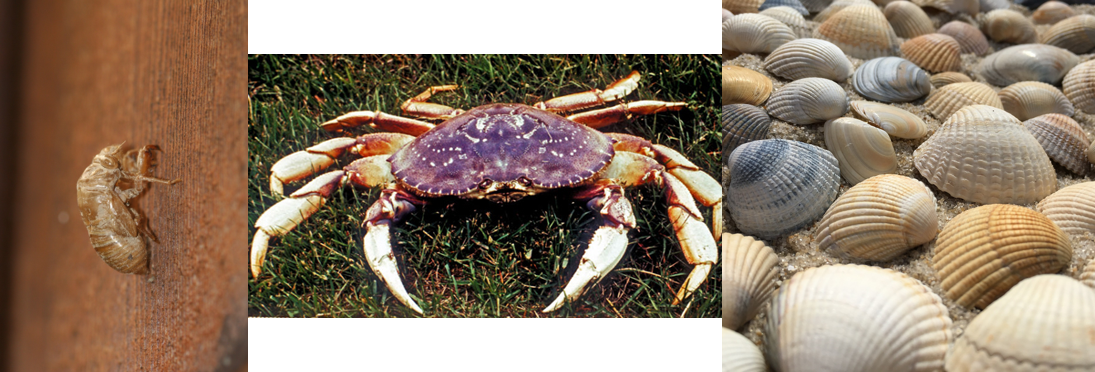37
Learning Goals
By the end of this reading you should be able to:
- Differentiate between different types of skeletons and give examples of organisms with each type
- Describe the advantages and disadvantages of each type of skeleton
Introduction

The earliest forms of life evolved in the oceans. The fact that this is an aquatic environment is key. Water is about 1,000 times denser than air. The high density of water allows organisms to float, due to a physical, upward force inherent in liquids known as buoyancy. Buoyancy allowed organisms to grow and reach large sizes because the buoyancy force supported the bodyweight of these animals. However, the density of water also provides resistance to movement, and animals had to adapt to ensure that they were able to move efficiently through the water.
An early adaptation by organisms was the ability to change the hydrostatic pressure within different chambers of their bodies to enable quick movement. This resulted in the development of hydrostatic skeletons. Animals with this type of skeleton include jellyfish, octopuses, and sea anemones. The changing shape of the animal reduces both friction and drag.
Over time, in order to refine movement and improve protection from predators, some organisms developed a hard chitinous exoskeleton. Exoskeletons first developed in the aquatic environment in ancient arthropods. Animals with this type of skeleton include crustaceans like crabs and lobsters.
Eventually, there were some animals that developed a skeletal structure internal to the body, which would become the vertebrate group of animals. These animals have an endoskeleton. Initially, all endoskeletons were made of cartilage, which is a dense rubbery type of tissue. Later, endoskeletons of bone evolved.
Hydrostatic Skeletons
A hydrostatic skeleton is a structure found in many cold-blooded and soft-bodied organisms. It consists of a fluid-filled cavity, which is surrounded by muscles. The cavity is called a coelom and in some animals, this cavity is filled with a blood-like substance called haemocoel. The fluid presses against the muscles, which in turn contract against the pressure of the fluid. The fluid is incompressible and thus maintains a constant volume against which the muscles can contract. The hydrostatic skeleton prevents the collapse of the body. The muscles in the body act against the fluid and in doing so bring about movement. If the body is segmented, the pressure of the fluid is localised in a few segments at a time. Hydrostatic skeletons occur in flatworms, roundworms, earthworms, starfish and slugs.

Movement in a hydrostatic skeleton is provided by muscles that surround the coelom. The muscles in a hydrostatic skeleton contract to change the shape of the coelom; the pressure of the fluid in the coelom produces movement. For example, earthworms move by waves of muscular contractions of the skeletal muscle of the body wall hydrostatic skeleton, called peristalsis, which alternately shorten and lengthen the body. Lengthening the body extends the anterior end of the organism. Most organisms have a mechanism to fix themselves in the substrate. Shortening the muscles then draws the posterior portion of the body forward. Although a hydrostatic skeleton is well-suited to invertebrate organisms such as earthworms and some aquatic organisms, it is not an efficient skeleton for terrestrial animals.
Advantages of a hydrostatic skeleton
- Fluid shape: This allows organisms with hydrostatic skeletons to fit through oddly shaped passages, which is useful for burrowing or swimming.
- Strength: Creatures with hydrostatic skeletons can squeeze between spaces and expand, making a ‘prying open’ movement which allows them to force their way into various regions of rock and soil surfaces.
- Healing: Healing takes place faster in organisms with hydrostatic skeletons than in organisms with bone structures. This is because the haemocoel contained within the hydrostatic skeleton is made up mostly of water, and thus, can be refilled quickly. This allows many organisms with hydrostatic skeletons such as earthworms to grow back their body mass after damage.
- Lightweight: The hydrostatic skeleton allows the animal to move in a more flexible manner as it requires very little muscle mass for movement.
- Circulation: The fluid cavity allows the circulation of nutrients and waste.
- Protection: The hydrostatic skeletons cushions the internal organs of the animal from shock.
- Suited to the environment: Hydrostatic skeletons are suited for life in moist or aquatic environments, depending on the animal’s adaptations.
Disadvantages of a hydrostatic skeleton
- Structure and surface for attachment: The hydrostatic skeleton lacks a structure and does not have surfaces for the attachment of muscles or limbs.
- Lack of protection: There is very little protection for the internal organs.
- Desiccation: A moist or water habitat is essential for the survival of these animals in order to prevent desiccation (drying out).
- Limited strength: Terrestrial animals with hydrostatic skeletons cannot increase their body size as they would collapse under their own body weight.
Review Question:
Exoskeletons
An exoskeleton is an external skeleton that supports and protects an animal’s body. The skeleton is non-living and consists of a cuticle strengthened by chitin, a substance secreted by the epidermis (skin). Crustaceans such as crabs have their exoskeleton further strengthened by calcium carbonate. There are muscles attached to the inside of the exoskeleton which provides the resistance needed for muscle action.
This skeleton-type provides defence against predators, supports the body, and allows for movement through the contraction of attached muscles. As with vertebrates, muscles must cross a joint inside the exoskeleton. Shortening of the muscle changes the relationship of the two segments of the exoskeleton. Arthropods such as crabs and lobsters have exoskeletons that consist of 30–50 per cent chitin, a polysaccharide derivative of glucose that is a strong but flexible material. Chitin is secreted by the epidermal cells. The exoskeleton is further strengthened by the addition of calcium carbonate in organisms such as the lobster. Because the exoskeleton is acellular, arthropods must periodically shed their exoskeletons because the exoskeleton does not grow as the organism grows.

The exoskeleton is confined to animals such as insects, spiders, scorpions, crabs etc., all of which belong to the Phylum Arthropoda (jointed-legged and jointed-bodied animals). The exoskeleton acts as a hard outer covering and is made up of a series of plates or tubes. We often call large exoskeletons `shells’.
Advantages of the exoskeleton
- Muscle attachment: The exoskeleton forms the point of attachment of internal muscles needed for locomotion thereby providing better leverage for muscle action.
- Protection: The exoskeleton protects the soft internal tissues and organs.
- Support: The exoskeleton provides structural support and shape.
- Prevents Desiccation: The exoskeleton prevents desiccation (drying out) on land.
- Light-weight: The exoskeleton of insects has a low density and is therefore lightweight, to allow for flight.
- Diversity: The mouth-parts can be modified for biting, sucking, piercing grasping thus providing for a diversified diet for organisms possessing an exoskeleton compared to those that do not.
Disadvantages of the exoskeleton
- Size restriction: The final body size is limited because as the body size increases, the surface area to volume ratio decreases. The larger the animal, the heavier the exoskeleton, making movement more difficult.
- The non-living skeleton does not grow with animals: The overall growth of the animal is restricted due to periodic moulting. Since the exoskeleton restricts growth, moulting is required to accommodate for increases in the size of the animal.
- Vulnerability during moulting: The animal is vulnerable when it is in the moulting process because the new skeleton is very soft until the new exoskeleton has dried and hardened.
- Sites of structural weakness: Exoskeletons are weaker at the joints.
Endoskeletons
An endoskeleton is a skeleton that consists of hard, mineralized structures located within the soft tissue of organisms. The bones of vertebrates are composed of tissues and can consist of bone (all vertebrates except sharks) or cartilage (sharks) and some endoskeletons consist of both. Endoskeletons provide support for the body, protect internal organs, and allow for movement through the contraction of muscles attached to the skeleton.

Advantages of the endoskeleton
- Living: Endoskeletons consist of living tissue, so it is able to grow steadily within the animal enabling some to reach a large size.
- Structure and support: The endoskeleton provides shape and structural support.
- Structural diversity and adaptation: The bones can vary in size and shape to support the animal’s mass.
- Flexible: The endoskeleton is jointed which allows for flexible movement and support.
- Muscle attachment: The muscles attach directly to the skeletal bones to allow for movement and support.
- Protection: The endoskeleton protects the vital organs such as the heart and lungs which are protected by the ribcage.
- Diversified locomotion: The development of an endoskeleton has allowed animals to become successfully adapted to locomotion in the environment in which they live. Vertebrates (organisms with a vertebral column and an endoskeleton) have become adapted to move in a number of different modes of locomotion, e.g. running, jumping, swimming, and flying.
Disadvantages of the endoskeleton
- Vulnerable to the external environment: The endoskeleton does not offer the animal any protection from the exterior, be it a physical attack or changes in environmental conditions. The animal is therefore very vulnerable.
- Susceptible to disease: The skeleton consists of living tissue so is susceptible to infections and disease.
Summary
The three types of skeleton designs are hydrostatic skeletons, exoskeletons, and endoskeletons. A hydrostatic skeleton is formed by a fluid-filled compartment held under hydrostatic pressure; movement is created by the muscles producing pressure on the fluid. An exoskeleton is a hard external skeleton that protects the outer surface of an organism and enables movement through muscles attached to the inside. An endoskeleton is an internal skeleton composed of hard, mineralized tissue that also enables movement by attachment to muscles.
REVIEW: Endo vs. Exoskeletons
REVIEW: Exoskeletons
3) As animals evolved to live on land they didn’t all adapt their skeletons in the same way. In a terrestrial environment what are the advantages of an exoskeleton? What about an endoskeleton?

